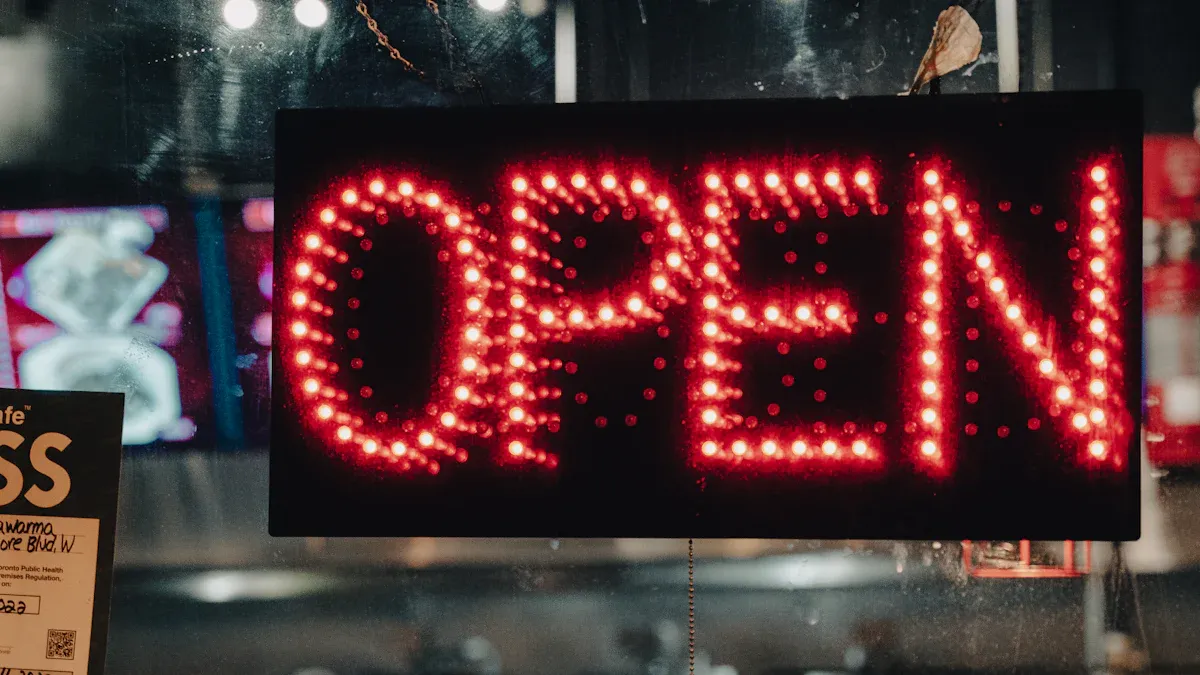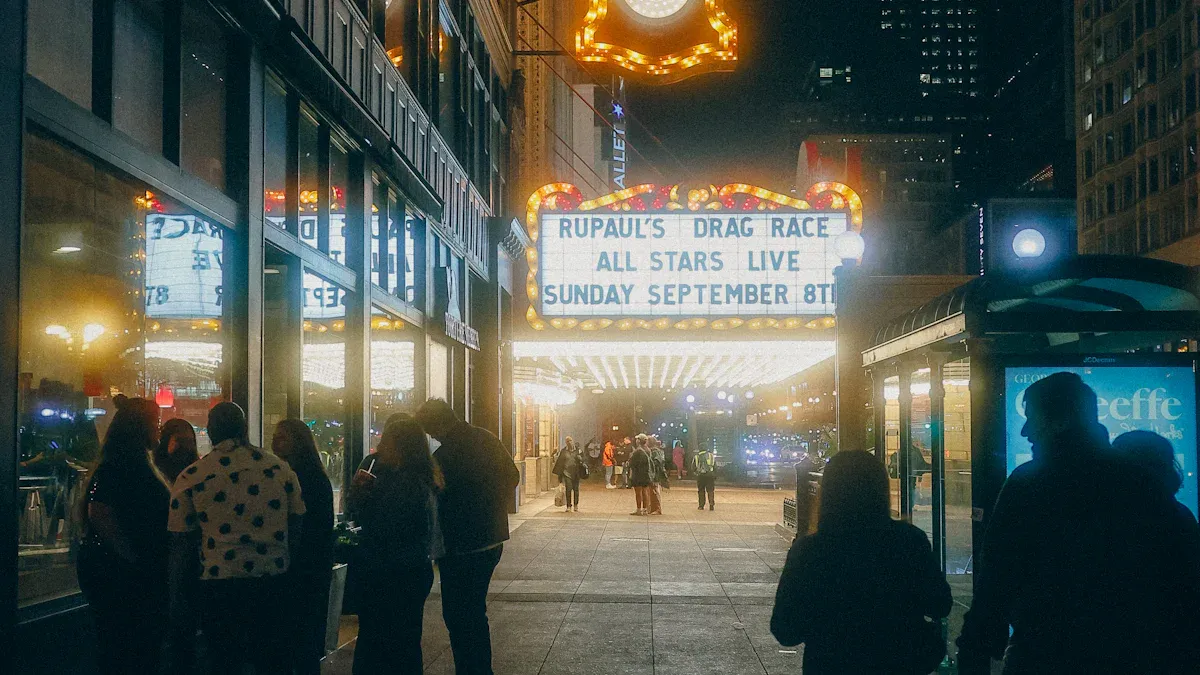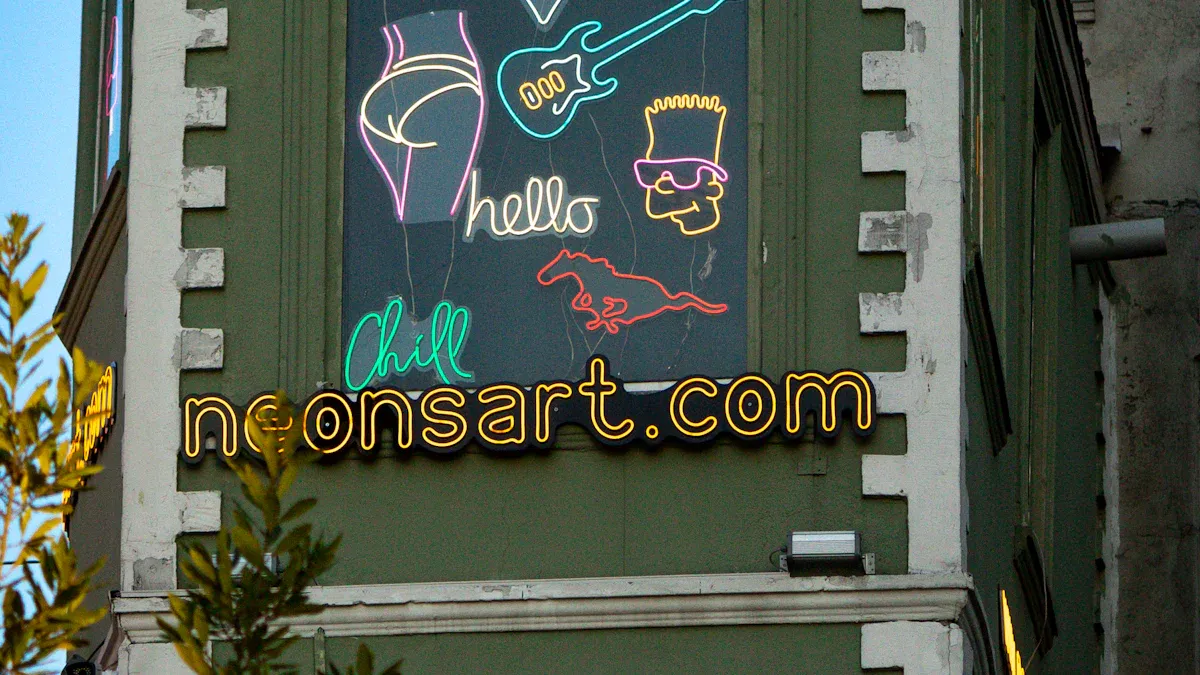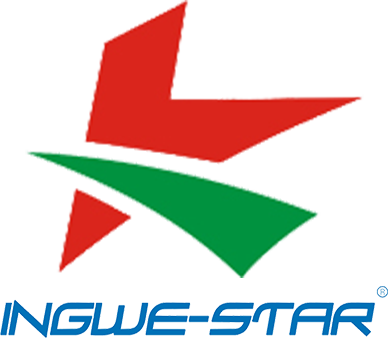Choosing the Right Illuminated Signage for Your Business Needs

You want people to notice your business, even at night. Illuminated signage helps your business get seen. Many businesses get 35% more visitors at night. Shoppers say signs help them decide where to go.
Visibility can increase by 60%.
Good signage makes your brand stronger and helps customers have a better experience.
Key Takeaways
Illuminated signage can make your business easier to see. It can boost visibility by up to 60%. This helps bring in more customers, especially at night.
Using the same branding on all signage builds trust. It also helps people remember your business. This makes your business look professional and dependable.
Pick the best spot for your signs to help people see them. Make sure they are easy to spot from busy streets or sidewalks.
Business Goals
Brand Identity
Your signs tell people about your business. Picking the right commercial signage helps people remember you. You should match your signs with your logo, colors, and style. This makes your business look honest and professional. Here are some ways signage can help your brand:
Aspect | Description |
|---|---|
Consistency | Using the same style for all signs helps people know your brand. |
Customization | Custom signs let you show your special style and message. |
Trust and Recognition | When signs match your brand, customers trust you more. |
Hotels often use fancy metal or soft LED signs. These signs make guests feel welcome and show your brand’s style. Restaurants and shops can use signage solutions to stand out in busy places.
Operational Needs
You want your signs to help you all day and night. Good commercial signage makes your business easy to spot, even when it is dark. Think about these things:
Illuminated signs help more people see your business at night.
Bright signs make your name and logo easy to read.
Nice-looking signs can bring in more people and make your place look friendly.
Some signs last a long time and do not need much care.
Always check local rules before putting up new signs.
If you work in healthcare or schools, clear signs help people find their way and feel safe. No matter what you do, the right signage helps your business and makes your brand stand out.
Types of Illuminated Signage

If you want your business to stand out, you have many illuminated sign choices. Each type has its own look, price, and use. Let’s look at the most common ones so you can choose what matches your brand and commercial signage needs.
Channel Letters
Channel letters are 3D letters that stick out from your building. You often see them on stores, clinics, and offices. They use aluminum and acrylic. You can light them up from inside or behind for a glowing effect. You can shape them to fit your logo or brand colors.
Tip: Channel letters make your business look sharp and professional. They help people see your name from far away.
Here are some good and bad things about channel letters:
Advantages | Disadvantages |
|---|---|
Easy to see, even at night | Cost more at first than some other signs |
Many ways to make them your own | Need more time and skill to put up |
Make your business look nice | Need more care, especially with old lights |
Strong and last a long time | Only work for 2D logos or designs |
Lightbox
Lightbox signs are a classic pick for shops and cafes. They have a metal frame and a plastic front that lights up from behind. You can print your logo or message on the front. These signs are easy to see, even in bad weather.
Lightbox signs light up the whole background, so your message stands out.
They cost less than some other lighted signs and are easy to care for.
Sign Type | Average Cost Range | Maintenance Considerations |
|---|---|---|
Lightbox Sign | $1,500 - $3,000 | Medium |
Neon Sign | More than lightbox | High |
Backlit Sign | Changes | Medium |
Note: Lightbox signs are great for retail shops, boutiques, and restaurants. They give a bright, even glow that gets attention.
Neon
Neon signs have an old-school style that stays popular. You see them in diners, bars, and cool shops. Neon tubes bend into letters or shapes and shine in bright colors. They look fun and can match your brand’s style.
But neon signs use more power and need more care than other lighted signs. They also cost more to run.
Signage Type | Voltage Needed | |
|---|---|---|
LED | Much less | Lower voltage |
Neon | Much more | 3,000 to 18,000 volts |
Neon signs only light up the letters or shapes, not the whole background. They stand out at night but may break more often.
LED Panels
LED panels are a modern choice for commercial signage. They use lots of tiny lights to make bright, colorful signs. You can show words, pictures, or even short videos. LED panels last a long time and use less power than neon.
A good outdoor LED panel can last 8 to 11 years, even if it is always on.
You can change the message anytime, which is good for sales or events.
LED panels are great for businesses that want to change messages often. They catch people’s eyes and save money on power.
Digital Signs
Digital signage is the next step up. These signs use screens to show videos, animations, or slideshows. You can update them right away, so your message is always new. Some digital signs let customers use touchscreens or scan QR codes.
Feature | Digital Signage | Traditional Signage |
|---|---|---|
Moving Content | Yes (videos, animations) | No (still content) |
Interactivity | Yes (touchscreens, QR codes) | No (no interaction) |
Real-Time Updates | Yes (instant updates) | No (fixed content) |
Audience Engagement | 400% more views than still displays | Fewer people look |
Digital signs get 400% more views than regular signs.
68% of shoppers say digital signs make them want to buy something.
You can show ads to different groups or at different times.
Digital signs help you talk to customers and keep your brand message fresh.
Comparing Popular Types of Illuminated Signs
Here’s a table to help you see the main differences:
Type of Signage | Materials and Structure | Pros | Use Cases |
|---|---|---|---|
Traditional Lightbox | Aluminum frame, acrylic face, LED or fluorescent lights | Good price, easy to care for | Retail shops, cafes, boutiques |
Channel Letter | Aluminum with acrylic faces, 2” to 6” deep | Great for branding, very strong | Offices, clinics, professional services |
Monument | Stone, concrete, or brick base, aluminum or HDU sign | Stands out, good for directions | Restaurants, hotels |
Towering Pylon | Steel pole, aluminum cabinet, acrylic face | Very easy to see, good for many tenants | Auto dealers, shopping centers |
LED | Electronic, fixed panels or moving messages | Bright, eye-catching, saves energy | Modern businesses, trade shows, busy streets |
Illuminated vs. Non-Illuminated Signs
You might wonder if you really need lighted signs. Here’s how they compare:
Feature | Illuminated Signs | Non-Illuminated Signs |
|---|---|---|
Visibility | Easy to see at night and from far away | Hard to see in the dark or from far away |
Cost | Costs more at first, but worth it later | Cheaper at first, but less effect |
Maintenance | Needs care and power | Less care, no power needed |
Brand Exposure | Works all day and night, always advertising | Only works during the day |
Design Flexibility | Many ways to customize | Simple designs can still work |
If you want your business to stand out day and night, illuminated signage is best. It helps people remember your brand and brings in more customers, even after dark.
Outdoor Business Sign

Placement
Choosing the right spot for your outdoor business sign can make a big difference. You want people to see your signage from far away and from different angles. Think about where your customers walk or drive. Place your sign where nothing blocks the view, like trees or other buildings. If your business sits on a busy street, make sure your outdoor signage faces the traffic. This helps you grab attention and boost business visibility.
Here are some things to keep in mind when picking a spot:
Make sure your sign follows local rules and city codes.
Check if your sign is easy to see from one or two sides.
Look at the line of sight from the road or sidewalk.
Use illumination options that make your signage stand out, even at night.
Tip: Signs that light up, like monochrome LED, lightbox, or halo-lit styles, work well in high-traffic spots. They help your brand shine and attract more people.
Materials
The materials you choose for your outdoor business sign matter a lot. Weather can be tough on signs, so you need something strong. Durable materials like aluminum, polycarbonate, and UV-coated vinyl protect your signage from fading, warping, or cracking. These materials help your sign last longer and save you money on repairs.
Outdoor signage with weatherproof features can handle rain, wind, and sun. This means your illuminated signs keep working and looking good, even in bad weather. When you invest in quality materials, your commercial signage stays bright and keeps showing off your brand.
Here’s how illuminated signage helps businesses after dark:
Benefit | Description |
|---|---|
Your sign stays bright at night, so customers can find you anytime. | |
Enhanced safety | Well-lit signs make your place feel safer and more welcoming. |
Increased foot traffic | Bright outdoor business signs catch eyes and bring in more people. |
Weather resilience | Your sign stays visible, even in rain or fog. |
Competitive edge | A glowing sign helps your business stand out from others nearby. |
A good outdoor business sign not only shows your brand but also keeps your business visible and safe, no matter the time or weather.
Visibility and Readability
Internal vs. External Illumination
When you choose signage, think about how it lights up. Internal illumination means the light is inside the sign. This makes the sign bright and easy to see. People can notice your sign from far away. If your business is in a busy place or your sign is small, internal illumination helps people find you fast. External illumination uses lights outside the sign. These lights can look nice but are not as good from far away. Sometimes, outside lights make shadows or dark spots on your sign. If you want your brand to stand out, internal illumination gives better visibility for your commercial signage.
Tip: Internal illumination is best for busy places or when you want your sign seen from far away.
Lighting Type
The lighting you pick matters for indoor and outdoor signs. LED lighting is the best for outdoor business signs. LEDs use less energy and give even light. This keeps your sign clear and easy to read. Good lighting helps your sign look sharp, even at night. Uneven lighting can make your sign hard to read, so try to avoid it. LEDs also work well for indoor signs. They keep your commercial signage bright and do not get too hot. If you use signs in lobbies, hallways, or meeting rooms, good lighting helps people find their way and remember your brand.
LED lighting saves money and lasts longer.
Even light makes your sign easy to read.
Good lighting helps your indoor sign look professional.
Remember: Bright, clear signs help customers feel welcome and make your business look great.
Signage Design
Message Clarity
When you design signage, your message should be clear and easy to read. You want people to understand your message in just a few seconds. Here are some tips to help you:
Use bold, simple fonts that stand out.
Pick a text size that people can see from far away.
Leave enough space between letters and words.
Keep your message short and to the point.
Avoid clutter by leaving white space around your message.
If you follow these design elements, your signage will grab attention and help customers remember your business. Always check local rules to make sure your signage fits the area.
Color
Color plays a big role in signage design. Did you know that up to 90% of a customer’s first impression comes from color? The right color can boost brand recognition by 80%. Different colors send different messages. Red feels energetic and urgent. Blue makes people think of trust and reliability. Choose colors that match your brand and make your message pop. Good color choices help your signage stand out, even in busy places.
Lighting Effects
Lighting effects can make your signage shine. Halo lighting creates a soft glow behind your letters, giving your sign an upscale look. Reverse channel lighting lights up the inside of each letter, making your message stand out at night. You can also use accent lighting to highlight special design elements or add depth. Task lighting works well for signs that need extra clarity, like directional or storefront signage. These lighting effects help your commercial signage catch eyes and make your message easy to see, day or night.
Budget and Maintenance
Cost
When you plan for illuminated signage, you want to know what it will cost. Prices can change a lot. Most small or medium businesses spend between $3,000 and $10,000 for a new sign. Some simple signs cost just a few hundred dollars. Large or custom signs, like channel letters or freestanding monument signs, can go over $20,000. Here’s a quick look at common price ranges:
Standard illuminated storefront signs: $3,000 – $7,000
Custom channel letters with lighting: $4,000 – $10,000+
Freestanding monument or pole signs: $5,000 – $20,000+
You should also think about the cost of running your signage. LED and digital signs use less energy, so you save money over time.
Installation
The price for installing signage depends on a few things:
The type of sign you pick
The size and how complex the sign is
Where you want to put it (high up, indoors, or outdoors)
Local rules and permits
The materials and how much you want to customize
Labor and how long it takes to install
Professional installation makes sure your signage looks great and works well. You want your sign to be safe and easy to see.
Longevity
You want your signage to last. LED signs can work for 5 to 10 years, or 50,000 to 100,000 hours. They need less care than old-style signs. Digital signage also lasts longer and saves you money on repairs. Common problems include burnt-out bulbs, flickering lights, or electrical issues. Weather and vandalism can also cause damage. LED and digital signs need less fixing, so you spend less on maintenance. A good sign gives your brand a strong look and keeps your business shining day and night.
Picking illuminated signage that matches your business goals, where you are, and your brand helps you get noticed.
Always use the same logo, colors, and message on your signs.
Put your sign in a spot where lots of people can see it.
Talk to sign experts if you need help.
Lighted signs help your business stand out all day and night!
FAQ
How long does it take to install illuminated signage?
Most signs go up in one to two days. Some bigger or custom signs may take longer. Your installer will let you know the exact time.
Can you use illuminated signs indoors?
Yes! You can use lighted signs in lobbies, hallways, or meeting rooms. They help people find their way and make your space look modern.
Do illuminated signs use a lot of electricity?
LED signs use very little power. Neon signs use more. If you want to save money, choose LED lighting for your business signage.
See Also
Selecting the Perfect LED Display Sign for Your Company
Finding the Ideal LED Digital Display Sign for Your Business
Essential Guide to LED Sign Boxes: Specs, Setup, and Returns
Acrylic Light Box Signs: Key Strategies for Enhancing Brand Exposure
Enhancing Visibility with Rotating LED Signs: Benefits and Insights

